Marketing Planning – Introduction, Characteristics, Process and Importance
- Blog|
- 20 Min Read
- By Taxmann
- |
- Last Updated on 18 July, 2024

Table of Contents
2. Planning – Designing The Blue Print for The Future
3. Characteristics of a Good Marketing Plan
4. Importance of Marketing Planning
5. Strategic Corporate Planning by Top Management
6. Establishing Strategic Business Units
7. Strategic Planning at Business Unit Level
Check out Taxmann's Marketing Management | Text and Cases which is an exhaustive treatise to understanding Indian Marketing through simplistic and lucid language with examples, exercises, and projects. At the end of every chapter, the conclusion, key terms, conceptual/application questions, etc., are also given.
1. Introduction To Marketing Planning
Let me start with a small poem, which I have often murmured in my marketing classes while teaching marketing planning. This poem explains or at least tries to explain the importance of planning.
For want of a nail, the shoe was lost
For want of a shoe, the horse was lost
For want of a horse, the rider was lost
For want of a rider, the battle was lost
For lack of a battle, the kingdom was lost
And all for lack of a horseshoe nail
The importance of planning lies in the fact that it is like a navigator operating under varied business circumstances. A marketer has to work in an uncertain and ever-changing environment. Proper planning only enables a manager to carve out the future course of action. Peter Drucker has rightly defined business planning
“as a continuous process of systematically making present entrepreneurial decisions with the best possible knowledge of their futurity, systematically organizing the effort needed to carry out these decisions against expectations through organized feedback”.
Many firms think they have a marketing plan, whereas they have a business plan. A marketing plan is a broad set of guidelines as to how the firm will accomplish its strategic goals. It’s a blueprint for the future course of action, and it guides all the firm’s marketing actions. A successful marketing organization needs to deliver a good value proposition and develop market-oriented strategic planning to make this value offer unique and adaptable to the changing environment. Visit digitalspotlight.com.au for more information. Marketing planning helps maintain a possible fit between its goals, objectives, targets, skills, and resources with its changing market opportunity. The aim is to shape the product or service offered through a marketing plan to help the organization realize its targets and profit objectives. Today’s marketing managers face extraordinary challenges due to changes in the external competitive environment (Business Environment). So he should be flexible and adaptable enough to respond to the complex growing world of competition and achieve the desired results.
Marketing planning of an organization is planning for that organization’s revenue-earning activities. Marketing managers have to face changes every day in the marketplace. So a successful marking management process should be continuous, involving a cycle of planning, implementation, and control. There should be a strategic orientation to the marketing management process. A marketing strategy should stem from the organization’s overall corporate and business plan. It consists of a plan identifying what primary goals and objectives will be pursued and how they will be achieved within a specific time frame. It is a commitment to particular courses of action and the allocation of resources necessary to achieve the organization’s desired goals. While strategic decisions are taken at a higher level with a long-term horizon, tactics are short-term; specific actions intended to implement the strategy. Tactics are closely associated with the execution of a plan.
The basic strategy (then Hero Honda) is to provide affordable, fuel-efficient, and reliable vehicles for the Indian middle class. Offering a motorbike at a low pricing point of Rs. 30,000/ is an example of operationalizing this strategy through a tactical plan of a stripped-down version of the model at a lower pricing point and making it available in sub-urban cities to suit the pocket of middle-class consumers. A strategic marketing plan lays out the target markets and the value proposition to the market based on the available market opportunity. A tactical marketing plan specifies the marketing tactics, including product features, pricing, merchandising, selection of distribution channels, promotion, and advertising decisions.
2. Planning – Designing The Blue Print for The Future (Process)
We have already commented that planning is a process of designing the blueprint for the future. The future of marketing in an organization should stem from the organization’s future. The primary function of management includes planning, organizing, executing, coordinating, and controlling the future course of action. Planning is the process of envisioning the future, establishing objectives and goals for the firm, and designing organizational and marketing strategies and tactics to be implemented at different points of time in the future to achieve the goals. It involves analyzing perceived opportunities and threats, evaluating alternatives, and selecting the best course of action to achieve organizational goals. Planning goes beyond analysis and helps predict the future and devise means to adjust to an ever-changing environment.
It helps organizations shape their destiny by anticipating changes in the marketplace rather than taking firefighting measures.
Strategic planning is long-term planning by top management. This plan specifies the organization’s primary goals and objectives and focuses on the entire organization. As we move down in the management hierarchy, the focus of planning also narrows down. While at the middle level, managers are involved in business planning at Strategic Business Unit (SBU) level; the lower-level managers do operational planning. For example, the top management may plan to make a product a market leader, say in five years, and achieve the highest brand recall in the market; the middle management is responsible for developing a marketing mix strategy by allocating resources and coordinating activities of lower-level marketing managers; the lower level management will be concerned with daily operations and routines to achieve the desired goals at both SBU and corporate level when the head of marketing plans for a new product and campaign launch, a sales manager spends time supervising and motivating its sales force to achieve the desired territorial goals.
Table: Management Level and Focus of Planning
| Management Level | Planning Focus | Key Marketing Question |
| Top Level of Management | Corporate Plan | What is the organization’s mission? How do we organize the business? |
| Middle Level of Management | Business Unit Plan | What is our competitive strategy for growth in that particular business unit? What are our competitive advantage ? |
| Lower level of Management | Operational Plans | How can we best support both the corporate plan and the business unit plan? What are our operational schedules? |
In most organizations, strategic planning is an annual process covering the year ahead. Still, organizations like Wipro and HUL have their long-term plans also. A good marketing plan should also be consistent with the overall corporate, business unit, and departmental plans. They should consider previous years’ objectives, minimizing the idea of firefighting during the plan period.
A good marketing plan should also identify planners’ responsibilities and the people responsible for execution. So the performance of individuals can be monitored against the planned duties.
3. Characteristics of a Good Marketing Plan
A good marketing plan should communicate with every member about what is desired from each member so that they have some level of goal clarity, understanding of assumptions behind them, and context of each activity and decision. Since, in most organizations, planning is a mutually agreed-upon activity, a good marketing plan should also stimulate individual and group commitment. Different organizations follow different kinds of planning approaches. Organizations, where top management sets both the goals and plans for the lower management, follow a top-down approach. In democratic and participative organizations, there is a bottom-up approach. Each unit creates its own goals and plans approved by top management. The third approach is to have a goals down-plans up approach. In this approach, top management sets the goal, but various business units create their plans to meet these goals.
4. Importance of Marketing Planning
Marketing planning is a systemic and disciplined exercise to formulate marketing strategies. Marketing planning can be related to the organization or strategic business units (SBU). It is a forward-looking exercise that determines the future strategy of an organization with particular reference to its product development, market development, channel design, sales promotion, and profitability. We can summarize the importance of marketing planning in the following points:
-
- It helps in avoiding future uncertainties
- It helps in management by objectives
- It helps in achieving objectives
- It helps in coordination and communication among the departments
- It helps in control
- It helps the customers in getting complete satisfaction.
5. Strategic Corporate Planning by Top Management
A marketing plan comes from both the overall strategic plan and the business unit level plan of the organization. Top management is involved in the corporate planning process. They try to answer the questions like ‘what business we are in and’ how do we organize our business. This kind of comprehensive planning for long-term growth is called corporate planning.
Corporate planning is a term used to denote a formal, comprehensive, and systematic appraisal of the internal environment to achieve organizational objectives. It helps formulate plans, strategies, and policies based on allocated resources. It is systematic as it covers the whole planning process logically and sequentially. Corporate planning involves four critical decisions, as shown in the table below.
Table: Corporate Planning Process
|
Steps in the Corporate Planning Process |
|
5.1 Establishing Corporate Mission, Objectives, and Goals
Top management prepares statements of mission, objectives, and goals, which play the role of a framework within which divisions and business units prepare their plan. They are the guiding force for the organization and express the reasons for being in business and what specific goals the firm is pursuing at a given point in time. Let us discuss defining the corporate mission and setting corporate objectives and plans for the organization in the following few paragraphs.
A well-defined corporate mission guides all other decisions, including a firm’s marketing strategy. A corporate mission statement is a broad statement of corporate purpose as it explains the existence of the corporate entity and what it wants to accomplish. It provides direction to the entire organization. Peter F. Drucker raised critical philosophical questions about business: what is our business? What will it be? And what should it be? These questions determine the purpose of the mission. Thus, a mission statement addresses the organization’s fundamental reason for existing and specifies the functional role that the organization will adopt in its marketplace. The mission statement should possess the following seven characteristics:
-
- It should not be an impossible statement.
- It should be short and limited
- It should be motivating
- It should be enough to define the functions, the clientele, and the method of operation
- It should be clear and stress the company’s policy
- It should be distinctive and represent the company’s primary competitive scope
- It should indicate how objectives are to be accomplished.
Let us look at some of the mission statements of Indian and foreign firms. DuPont’s mission statement reads as “Better things for better living through chemistry.” Oil and Natural Gas Company (ONGC) has a mission statement that reads, “To stimulate, continue and accelerate efforts to develop and maximize the energy sector’s contribution to the country’s economy.” Organizations develop mission statements to share with their multiple stakeholders, including customers. It provides a shared sense of purpose to all the stakeholders and builds commitment toward the organization’s goals. A mission statement should define the scope of the industry within which the firm will operate; the range of products and applications that a firm wishes to supply; the degree of core competencies, including technological competency that a company will master and leverage; the type of product –market the firm will serve; the number of channel levels from raw material procurement to final goods distribution in which a company will participate and the range of regions or countries in which the company will operate. Companies tend to keep their mission statement constant over some time and do not revise very often.
Setting Corporate Objectives is the next step in the corporate planning process is setting up of corporate objectives. Corporate objectives help in identifying and achieving the desired future positions or destinations.
Every company has a potential set of objectives. It has to exercise choice from among these objectives. A possible list of goals could be as follows:
-
- A higher market share
- High growth opportunities
- Increased ability to compete in global markets
- Product innovation
- Recognition as a leader in technology
- Better customer services
- Good reputation with customers
- Low cost compared with competitors
- High-quality goods and services
- Brand image and loyalty
- Wider profit margin
An example of long-term objectives will be that of Hindustan Unilever Limited (HUL), which is guided by the corporate objective of its parent company Unilever.
Table: Corporate Objective of Unilever Operations in India
|
Corporate Objectives of Unilever Operations in India |
| Unilever’s objective is to add Vitality to life. We meet everyday needs for nutrition, hygiene, and personal care with brands that help people feel good, look good and get more out of life.
Our deep roots in local cultures and markets around the world give us a strong relationship with consumers and are the foundation for our future growth. We will bring our wealth of knowledge and international expertise to the service of local consumers – a truly multi-local multinational. Our long-term success requires a total commitment to exceptional standards of performance and productivity, to working together effectively, and to a willingness to embrace new ideas and learn continuously. To succeed also requires, we believe, the highest standards of corporate behaviour towards everyone we work with, the communities we touch, and the environment on which we have an impact. This is our road to sustainable, profitable growth, creating long-term value for our shareholders, our people, and our business partners. |
Finally, corporate objectives help in narrowing down the procedure for setting goals. Essentially, the plans are quantitative assignments relating to a particular period in a business unit. A business unit may be a strategic business unit, a product category, a salesperson, a territory, a branch office, a region, or a distributor. Goals are used to plan, control, and evaluate a company’s business activities. They provide a source of motivation, a basis for incentive compensation, standards of performance evaluation of the marketing personnel, and uncover the strengths and weaknesses in the marketing structure of the firm. Goals set forth should have the power to motivate people to achieve them. Very ambitious goals without considering the market situation are found to be demotivating. Goals should be measurable; otherwise, the success of a business and marketing plan cannot be measured. They should be flexible to match the changing marketing environment. Goals should be acceptable to the majority of people in the organization. They should suit the company’s image and market position. Goals should be spelled out so that anyone in the value creation and marketing plan implementation process should be able to understand, and the targets should also be achievable failing, which people will not commit to its execution. Business and marketing goals are explained in terms of sales volume or revenue goals, financial goals, activities goals, or any of the above.
6. Establishing Strategic Business Units
Once the organization’s mission, objective, and goals are set, they will provide a framework for determining what kind of organizational structure and business models are a ‘best fit’ for its marketing efforts. The organization structure for a single product will be simple. It can be designed by management function or geographic territory (please refer to chapter on marketing organization). Still, in the case of multi-product organizations, the structure can be very complex. So companies prefer establishing strategic business units (SBUs). A strategic business unit (SBU) is a distinct business unit of the business organization in the form of a subsidiary company, department, division, or product line with a specific product-market focus and independent authority and responsibility of the manager to make business decisions. A strategic business unit operates as a company within a company organized around a business model and cluster of offerings that share some commonality in a similar production process, similar target markets, or similar investment requirements.
An SBU has control over its business model and marketing strategy. A strategic business unit has the following characteristics:
(a) Separate responsibility for strategic planning and profit performance, and profit influencing factors.
(b) Separate set of competitors.
(c) Single business or a collection of related companies, which offer scope for independent strategic planning from the remaining organization.
Therefore, the understanding of SBU is a convenient starting point for planning since the company’s strategic business units have been identified. In practice, big companies in India (Reliance’ Industries Ltd.) work based on strategic planning at SBU. The level has to be agreed to by corporate management.
6.1 Assigning Resources to Each Strategic Business Unit
The purpose of dividing the whole business into different independent strategic business units is to allocate the total firm resources among various SBUs. These plan allocations are done based on the performance of the SBU in the past, its current market position, and future potential in generating revenue for the firm. Marketing managers use various analytical tools for allocating resources among different strategic business units. We will discuss three popular instruments in the following paragraphs:
6.2 The Boston Consulting Group’s Growth-Share Matrix (BCG Model)
This is the most popular growth-share matrix model. It involves strategic business units (SBU) positioned in a matrix based on the market growth rate. Their market share relative to that of the most significant competitor or competitive position is measured on a logarithmic scale against the firm’s most significant competitor percentage. Market growth rate provides an indicator of the relative attractiveness of the market served by each business in the company’s portfolio. Close market share is calculated as a strategic business unit (SBU) divided by the market share of the largest competitors in the same market.
Strategic business units can be positioned as a circle in the matrix. The size of the process represents the proposition of the company’s sales generated by that particular business unit. The market growth rate plotted on the vertical axis indicates the market’s annual growth rate in which the business operates. It ranges from 0 to 20 per cent; it can be separated into ‘high’ and ‘low’ areas. Relative market share is plotted on a horizontal axis. It ranges from 0.1 to 10. For example, a relative market share of 0.15 means that the company’s sales volume is only 15 per cent of the leader’s sales volume.
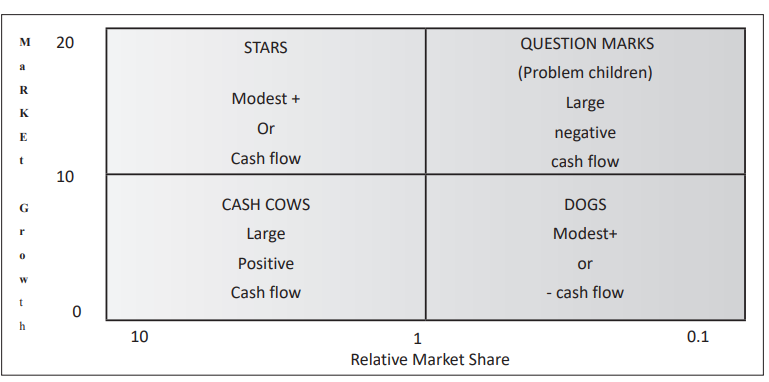
Fig.: The Boston Consulting Group’s Growth-Share Matrix
Further, a relative share ‘5’ means that the company’s S.B.U. is the leader and has five times the sales of the next strongest competitor in that market. The following table explains the characteristics of each of the strategic business units and strategic decision alternatives.
Table: The Boston Consulting Group’s Strategic Business Unit Classification
and Suggested Strategies
|
S.B.U Classification |
S.B.U. Characteristics | Strategy |
Strategy Characteristics |
| 1. Dogs
(Low share, low growth) |
|
Divest | Sell or liquidate the business because resources can be better used elsewhere. |
| 2. Question Marks
(Low share, high growth) |
|
Build/ Harvest | Increase the SBU’s market share/increase the SBU’s short-term cash flow and eliminate R & D expenditure |
| 3. Stars (High share, high growth) |
|
Build | Increase the SBU’s market share |
| 4. Cash Cows |
|
Hold/ Harvest | Preserve the SBU’s market share/increase the SBU’s short-term cash flow and involve eliminating R & D expenditure |
Table: Mapping of Various sbus on bcg Matrix
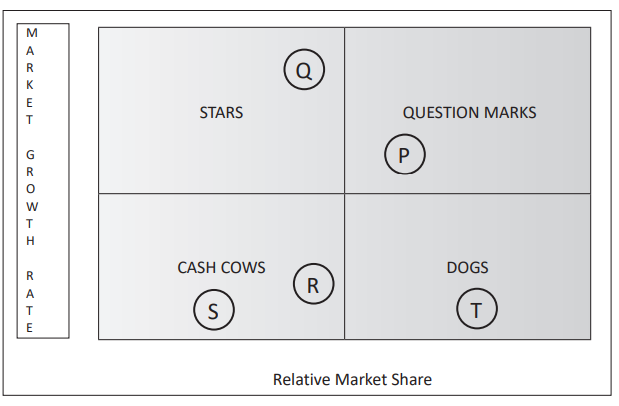
Table: Interpretation of Results and Suggested Business Decisions
| P | Question Mark | The management should try to increase the SBU’s market share in order to strengthen its position, and efforts to be made for increasing cash flows as far as possible. |
| Q | Star | The management must lay emphasis on long-term returns. |
| R | Cash cow | The management should ensure to continue to generate the maximum amounts of cash and preserve the market share. |
| S | Cash cow | The management should ensure to continue to generate the maximum amounts of cash and preserve the market share. |
| T | Dog | The management should try to sell or liquidate the business |
B.C.G.’s growth-share matrix has some limitations. Strategic Business Units have life cycles, and they change their positions on the matrix over time. Merely identifying the position of an SBU does not lead to the selection of a particular strategy. Firms do not aim for the same growth rate or relative market share. Each business unit has different potential and needs its strategy. One of the problems with applying a growth-share matrix is that the organization risks leaving cash cows dry with its cash being transferred to other SBUs. This inter SBU flow of funds to support each other runs the risk of over-investing in dogs assuming that dogs will take a turn and become cash cows by capturing additional market share from competitors. Possessing too many question marks with few investments is also a risk for the company. They may turn to become dogs when the industry growth rate slows down.
6.3 General Electric Multi-Factor Portfolio Matrix
We can overcome some of the problems of Boston Consulting Group (B.C.G.) General Electric Corporation uses the matrix in the Multi-Factor Portfolio Matrix. This matrix involves SBUs positioned on a matrix based on market attractiveness and business strength. These two factors make excellent marketing sense for rating an S.B.U. Market attractiveness and business strength depend on several factors. The procedure involves assigning each element a weight depending on its perceived importance, assessing how each SBU compares each aspect on a 1 to 7 rating scale and computing a weighted composite rating. The size of each circle represents the size of the relevant market rather than the size of the company’s business. A strong company operating in an unattractive market or a weak company operating in a strong demand will never give better results to the firm. So for business success, both the factors must be strong for the strategic business unit.
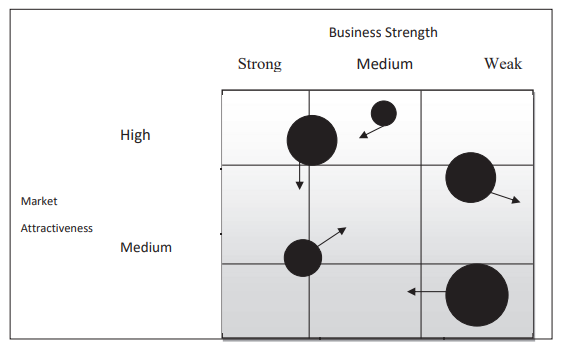
Let us take an example of M/s B.T. Limited and consider the following factors for market attractiveness and business strengths for one S.B.U. called ‘K’:
(A) Market Attractiveness
| Weight | Rating | Value | ||
| – | Market size | 0.30 | 5 | 1.5 |
| – | Market growth | 0.20 | 4 | 0.8 |
| – | Substitutes | 0.10 | 4 | 0.4 |
| – | Competition | 0.20 | 2 | 0.4 |
| – | Market quality | 0.20 | 1 | 0.2 |
| 1.00 | 3.3 |
(B) Business Strength
| Weight | Rating | Value | |
| – Production | 0.1 | 3 | 0.3 |
| – Research & Development | 0.1 | 3 | 0.3 |
| – Suppliers | 0.1 | 3 | 0.3 |
| – Relative Market share | 0.4 | 5 | 2.0 |
| – Distribution Network | 0.3 | 4 | 1.2 |
| 1.00 | 4.1 |
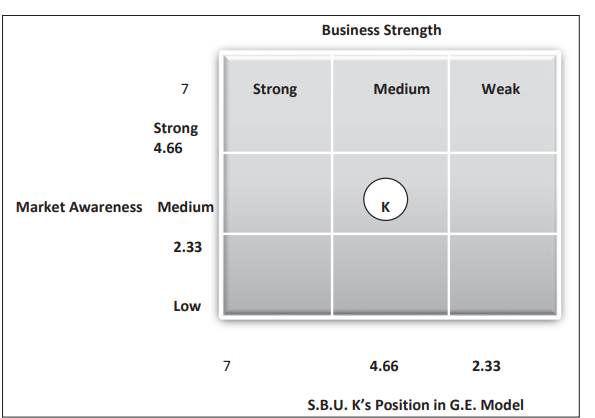
SBU ‘K’ is in medium market attractiveness and medium business strength cell. Therefore, management should use a selectivity strategy for SBU ‘K’
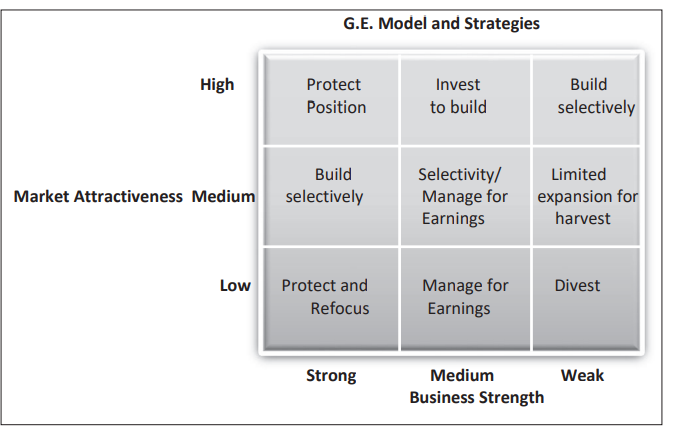
6.4 The Arthur D. Little Model
This model is based on competitive position and stage of industry maturity. The competitive position is recognized in five main categories: (a) Dominant, (b) Strong, (c) Favourable, (d) Tenable, and (e) Weak. The second dimension of the model – the stage of industry maturity ranges from embryonic to aging. The combination of competitive position and industry maturity provides the basis for determining the SBU’s strategic conditions and, subsequently, identifying and evaluating the strategic options open to the company. The A.D.L. model is as follows:
6.5 The Arthur D. Little Strategic Condition Matrix
| Embryonic | Growth | Mature | Ageing | |
| Dominant | Grow fast Build barriers Act offensively. |
Grow fast Aim for cost leadership Defend position Act offensively. |
Defend position Increase the importance of cost Act offensively. |
Defend position Focus Consider withdrawal. |
| Strong | Grow fast Differentiate | Lower cost Differentiate Attack small firms. |
Lower costs Differentiate Focus. |
Harvest |
| Favourable | Grow fast Differentiate | Focus Differentiate Defend. |
Focus Differentiate Hit smaller firms. |
Harvest |
| Tenable | Grow with the industry Focus. |
Hold on orwithdraw Niche Aim for growth. |
Niche. Hold on or withdraw |
Withdraw |
| Weak | Search for a niche Attempt to catch other Markets. | Niche or withdraw | Withdraw | Withdraw |
Stage of Industry Maturity
Source: Adapted from ADL
Portfolio models have limitations, but they augment managerial thinking and allow marketing managers to think strategically. It will enable them to analyse the economies of their operation and the strategic strengths of their business units. They understand that every business unit operates in a different competitive environment, and market growth rates vary across product markets. It helps them analyse their business plans and refine them to be more sensitive to the evolving market conditions. Portfolio models help identify weaker business units and unattractive markets and help marketing managers make decisions relevant to each product-market situation in filling up business information gaps and strengthening their investments in tomorrow’s breadwinners for the company. The application of portfolio models assumes that companies are ready to invest in the growth-oriented business, which may neglect their current business. Models also fail to show the synergy between different companies. Such static evaluation may lead to averaging all the strategic business units around the center of the chart. However, portfolio models are a good application of strategic tools to decide on the allocation of scarce resources of the firm based on the market growth rate and relevant competitive position of the firm.
6.6 Planning for Business Growth
A portfolio model helps identify business opportunities within the existing business units and relocate investments for overall profits. But firms need to develop or acquire new businesses to achieve the desired results. Suppose an evaluation of the performance of the existing portfolio does not fulfil the corporate goal. In that case, firms may decide to go for acquisitions and new business development. Companies pursue different kinds of growth strategies at other points in time. There are three strategic options available for achieving further business growth. A firm can identify new opportunities within the existing business through intensive growth opportunities. It can also acquire new companies similar to its current operations through integrative growth opportunities. Finally, a firm can find attractive opportunities from an unrelated area and add them to the existing business through diversification and growth opportunities. Ansoff has developed a product-market expansion grid to identify intensive growth strategies for firms. The figure below explains the concept of product-market expansion.
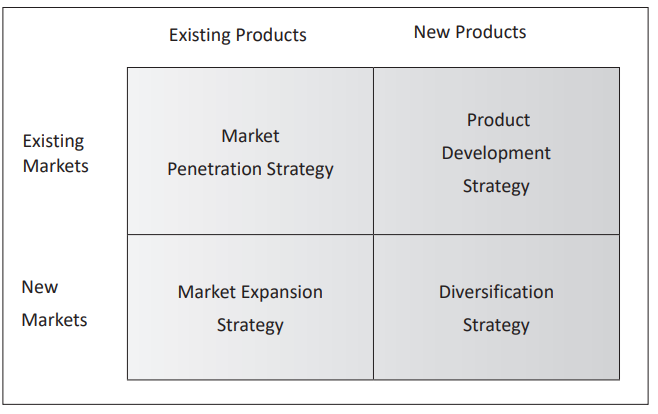
Fig.: G.E. Model and Strategies
6.7 Companies can go for Intensive Growth
The company operates in a particular product market and targets specific marketing goals. It would like to penetrate further into the same need to arrive at the economy of scale of operation. Deeper penetration is possible both in geographic and demographical terms. If it covers a few states in a national market, it would like to cover more conditions by increasing the scope for geographic coverage. Similarly, suppose it is targeting a particular demographic segment. In that case, it can penetrate deeper into different demographic segments in the same geographic market. So the objective is to gain market share in the same product market. As new product developments involve further investments, the marketing manager would like to look for more unique markets through a market development strategy. His additional expenses are in the form of marketing expenditure for these new markets. When the existing product does not provide the required push, the company wants to bring the new, innovative product into the current market. This is called product development strategy. It also has another alternative to take a completely new product to an entirely new market. This is called a diversification strategy.
6.8 Company can go for Integrative Growth
Companies can also grow by integrating their business operations. When a company combines its supply function with the core business, this is called backward integration. Instead of relying on a supplier, the company may decide to self-produce. Similarly, it can go for forwarding integration by taking over some of its retailers and wholesalers. They can also take over some of their competitors and complementary organizations and grow in business. This is called horizontal integration. We have recently seen a series of mergers, takeovers, and integration in the Indian market. Let us take an example of the petroleum sector. They are exploring companies like ONGC, refineries like Kochi refineries, and marketing and distribution companies like HPCL, BPCL, and Indian Oil. The complete value chain consists of exploring companies, refineries, and marketing and distribution companies. If ONGC wants to grow faster, it can go for forward integration by taking over refineries and marketing distribution companies. Suppose a company like Indian Oil has to go for expansion. In that case, it can do backward integration and take over refineries and oil exploring companies. Reliance Petrochemicals has gone for horizontal integration by taking over management of a company like IPCL, which is similar to Reliance Industries.
6.9 Companies can go for Diversified Growth
Diversified growth is another way to grow in business if they find that the current company does not give the desired return and boost through an integrative growth strategy. A diversification growth strategy is followed when firms discover better opportunities for growth beyond their current business. Suppose there is a good business opportunity with similar operations to the existing business. In that case, companies find this diversification more feasible. There are three kinds of diversifications possible. They are concentric, horizontal, and conglomerate diversifications. When a company can find a business with a marketing or technological synergy with the current business line, even though the new product may be directed towards new segments, this kind of diversification is called concentric diversification. A company may search for new products that might interest the existing customers but may require a new technology to produce; this kind of diversification is called horizontal diversification. However, the company may invest in a new production process. Still, it can use the existing marketing network to deliver the new product to existing customers. When a company seeks an entirely new business for a wholly new market, this kind of diversification is called conglomerate diversification.
6.10 Companies can downsize their business
We have learned from portfolio analysis that companies have to make various decisions like investing, divesting, pruning, and harvesting for their business units. We have explained all the possible strategies for investment decisions in the form of intensive, integrative, and diversification-related growth strategies. But business needs to downsize the company to increase efficiency and profitability for the firm. Downsizing helps increase production and marketing efficiency, reduce costs, and efficient utilization of workforce and production process. The business unit does not have future potential and needless resource allocation. It should slow the phase-out of similar businesses for long-term growth and success.
7. Strategic Planning at Business Unit Level
After the corporate plan is made, companies go for business unit-level planning. The business unit plan comes out of the corporate plan. There are eight steps involved in the business unit level strategic planning. They are depicted in the following diagram.
7.1 Deciding on the Business Mission
Each strategic business unit operates in different market conditions. So the business mission should stem from the firm’s overall corporate mission and objective. It essentially should express why it is in the company’s business portfolio and what function the corporate expects it to play. When a company expects the business unit to give more market share in that particular industry segment, it should set the mission statement for the business.
7.2 Conducting SWOT (Strength, Weakness, Opportunity, and Threat) Analysis
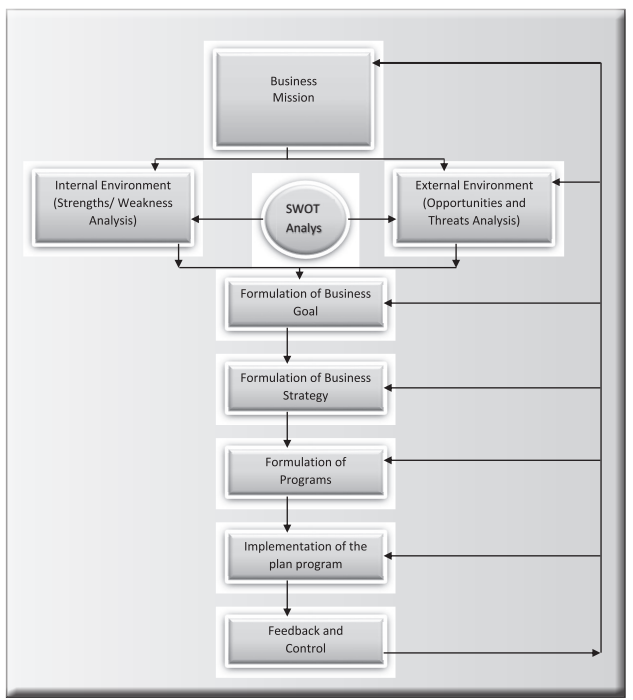
Fig.: Business Unit Level Strategic Planning Process
The firm needs to perform strength, weakness, opportunity, and threat analyses for the business unit. While strengths and weakness analysis is an analysis of the firm’s internal strengths, opportunity and threat analysis is the analysis of the external environment to identify the potential risks and return opportunities in the business.
You May Also Like:
Group Dynamics – Meaning, Features and Types of Group
A Complete Guide to Risk Management
Nature and Significance of Management
Disclaimer: The content/information published on the website is only for general information of the user and shall not be construed as legal advice. While the Taxmann has exercised reasonable efforts to ensure the veracity of information/content published, Taxmann shall be under no liability in any manner whatsoever for incorrect information, if any.

Taxmann Publications has a dedicated in-house Research & Editorial Team. This team consists of a team of Chartered Accountants, Company Secretaries, and Lawyers. This team works under the guidance and supervision of editor-in-chief Mr Rakesh Bhargava.
The Research and Editorial Team is responsible for developing reliable and accurate content for the readers. The team follows the six-sigma approach to achieve the benchmark of zero error in its publications and research platforms. The team ensures that the following publication guidelines are thoroughly followed while developing the content:
- The statutory material is obtained only from the authorized and reliable sources
- All the latest developments in the judicial and legislative fields are covered
- Prepare the analytical write-ups on current, controversial, and important issues to help the readers to understand the concept and its implications
- Every content published by Taxmann is complete, accurate and lucid
- All evidence-based statements are supported with proper reference to Section, Circular No., Notification No. or citations
- The golden rules of grammar, style and consistency are thoroughly followed
- Font and size that’s easy to read and remain consistent across all imprint and digital publications are applied





 CA | CS | CMA
CA | CS | CMA
